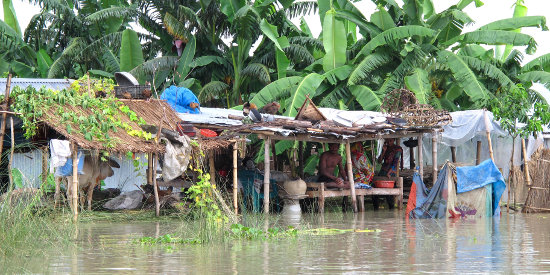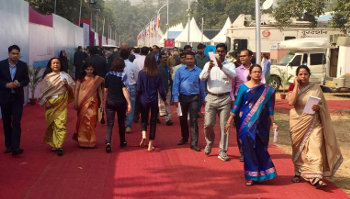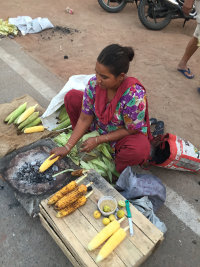The Sendai Framework laid out an ambitious agenda for DRR, and Asian nations have a plan to put it into action – but more needs to be done to address the underlying drivers of risk.

Earlier this month, more than 4,000 people gathered in New Delhi for the 2016 Asian Ministerial Conference on Disaster Risk Reduction, the first regional ministerial meeting on DRR since adoption of the Sendai Framework for Disaster Risk Reduction 2015–2030.
The conference aimed to turn the commitments made in Sendai last year into action, setting the course for implementation through the endorsed Asia Regional Plan for Implementation of the Sendai Framework.
Five researchers in SEI’s Initiative on Transforming Development and Disaster Risk (TDDR) participated in the conference. Below are our main takeaways.
The policy processes that led to the adoption of the Sendai Framework, the Sustainable Development Goals and the Paris Agreement on climate change highlighted the importance of policy coherence. The Sendai Framework in particular emphasizes the need to better integrate risk reduction into development, and identifies resilience as a common element between the two.

Yet to date, that vision has not been translated into a policy or detailed plan. The Asia Regional Plan does not significantly advance the DRR community in this regard. At AMCDRR, we saw several presentations on collaborative initiatives to build resilience across Asia. However, it remains unclear how resilient outcomes will actually be achieved, particularly for the most at risk communities.
Furthermore, some argue that building resilience is not enough to overcome major drivers of risk, including unsustainable development. TDDR is based on the premise that we need a transformation, particularly of the relationship between development and disaster risk. However, neither the Sendai Framework nor the Asia Regional Plan aim for transformative change. This could greatly limit DRR advances in the region.
Evaluations of the Hyogo Framework (2005–2015) found that most countries have made the least progress in addressing underlying factors that exacerbate disaster risk, such as poverty, inequality, climate change and variability, rapid and unplanned urbanization, poorly planned development, and weak institutions. The Sendai Framework aims to help countries better address these factors.

The Asia Regional Plan recognizes the problem, noting that “underlying risk drivers are not well identified and understood nor adequately addressed because of capacity constraints, lack of priority and a scarcity of resources”. But how will the DRR community and, particularly, national disaster management offices be able to fix development processes that are perpetuating existing risks and creating new ones?
DRR policy-makers and practitioners cannot solve this problem alone – they need to work in partnership with actors in key development sectors. However, those actors were mostly absent from AMCDRR, and their perspectives did not get much attention. Does the development community in Asia agree that “development practices need to be better risk-informed”?
Moving forward, more national and regional collaboration is needed. As a high-level regional forum, AMCDRR is well positioned to actively promote DRR-development engagement focused on addressing the underlying drivers of risk that are so prevalent in Asia.
Consistent with the Sendai Framework, and in response to strong advocacy by stakeholder groups, populations seen as particularly vulnerable – the poor, children, women, people with disabilities – have been explicitly included in the AMCDRR’s processes and outcome.
The Asia Regional Plan supports improved disaggregation of data, calling on all countries in Asia to establish methodologies for collecting disaster loss data and risk profiles, broken down by gender, age and disability status, by 2020. This long-overdue improvement will help countries understand vulnerabilities and devising more effective DRR interventions.
Yet this is just one piece of the puzzle. More needs to be done to design and implement tools and processes that enable effective empowerment and achieve social equity within DRR at the local level. This has to be done alongside efforts to measure and operationalize community- and household-level resilience. It is important to recognize and promote vulnerable people’s capacities as agents of change. Empowerment and equity are thus central to DRR.
Disasters do not recognize political boundaries. Regional and cross-border risks are key features of the disaster risk profile of many countries in Asia. Particularly since the Indian Ocean Tsunami in 2004, which affected close to 10 Asian countries, international efforts have been made to address transboundary risks. The Indian Ocean Tsunami early warning system is a prized success of regional DRR processes in Asia.

The Asia Regional Plan calls on regional intergovernmental organizations such as the Association of Southeast Asian Nations (ASEAN) to strengthen their capacities for regional cooperation in addressing transboundary risks – for example, through science-based transboundary risk assessments, development of common tools, and knowledge-sharing.
However, the focus is only on early warning and disaster preparedness, and more regional action is needed to address underlying risk drivers. Regional risk reduction can be driven by regional-level development processes and decision-making, too. Mechanisms could be created to allow developing countries in the region to learn from developed countries about risk-informed policies and development endeavours, and not just about disaster risk management action.
Understanding transboundary risks in Asia should also involve wider and more meaningful stakeholder collaboration at all levels. More adaptive governance processes are required, and learning networks have a role to play in enhancing knowledge and building capacity.
Better evidence and informed solutions for reducing risk are greatly needed in Asia, particularly on how to tackle underlying drivers of risk and vulnerability that are intimately linked with development.
The Asia Regional Plan roadmap presents opportunities for this, requiring that by 2018, 40% of countries establish multi-sectoral and multi-stakeholder national and local platforms to foster “dialogue and cooperation between governments, science and technology community and other stakeholders for risk-sensitive development and innovative risk management”.
The importance of science and new knowledge needs to be highlighted even more. Science and technology in DRR are also still weighted towards advancing technical solutions to hazards rather than to better understanding what drives vulnerability; this gap needs to be addressed.
The research community has a responsibility to support and advance the policies and practices of DRR actors. Bodies such as the Asian Science and Technology Advisory Group and the United Nations Office for Disaster Risk Reduction (UNISDR)’s Scientific and Technical Advisory Group (STAG) are key to driving such efforts, in partnership with national level actors, to ensure that the science being generated is policy-relevant. Through TDDR, SEI is committed to substantially contributing to this endeavour.
Head of Knowledge Management, Senior Research Fellow
Global Operations
SEI Headquarters
Design and development by Soapbox.


